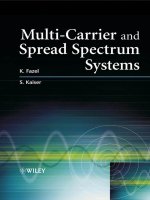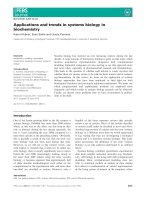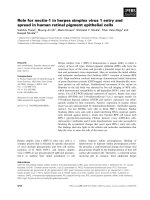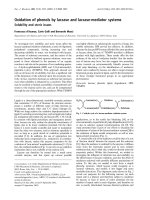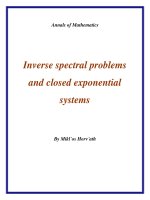Multi-Carrier and Spread Spectrum Systems
Bạn đang xem bản rút gọn của tài liệu. Xem và tải ngay bản đầy đủ của tài liệu tại đây (2.02 MB, 300 trang )
Multi-Carrier
and Spread Spectrum
Systems
K. Fazel
Marconi Communications GmbH
Germany
and
S. Kaiser
German Aerospace Center (DLR)
Germany
Multi-Carrier
and Spread Spectrum
Systems
Multi-Carrier
and Spread Spectrum
Systems
K. Fazel
Marconi Communications GmbH
Germany
and
S. Kaiser
German Aerospace Center (DLR)
Germany
Copyright
2003 John Wiley & Sons Ltd, The Atrium, Southern Gate, Chichester,
West Sussex PO19 8SQ, England
Telephone (
+
44) 1243 779777
Email (for orders and customer service enquiries):
Visit our Home Page on www.wileyeurope.com or www.wiley.com
All Rights Reserved. No part of this publication may be reproduced, stored in a retrieval system or
transmitted in any form or by any means, electronic, mechanical, photocopying, recording, scanning or
otherwise, except under the terms of the Copyright, Designs and Patents Act 1988 or under the terms
of a licence issued by the Copyright Licensing Agency Ltd, 90 Tottenham Court Road, London W1T
4LP, UK, without the permission in writing of the Publisher. Requests to the Publisher should be
addressed to the Permissions Department, John Wiley & Sons Ltd, The Atrium, Southern Gate,
Chichester, West Sussex PO19 8SQ, England, or emailed to , or faxed to
(
+
44) 1243 770620.
This publication is designed to provide accurate and authoritative information in regard to the subject
matter covered. It is sold on the understanding that the Publisher is not engaged in rendering
professional services. If professional advice or other expert assistance is required, the services of a
competent professional should be sought.
Other Wiley Editorial Offices
John Wiley & Sons Inc., 111 River Street, Hoboken, NJ 07030, USA
Jossey-Bass, 989 Market Street, San Francisco, CA 94103-1741, USA
Wiley-VCH Verlag GmbH, Boschstr. 12, D-69469 Weinheim, Germany
John Wiley & Sons Australia Ltd, 33 Park Road, Milton, Queensland 4064, Australia
John Wiley & Sons (Asia) Pte Ltd, 2 Clementi Loop #02-01, Jin Xing Distripark, Singapore 129809
John Wiley & Sons Canada Ltd, 22 Worcester Road, Etobicoke, Ontario, Canada M9W 1L1
Wiley also publishes its books in a variety of electronic formats. Some content that appears
in print may not be available in electronic books.
Library of Congress Cataloging-in-Publication Data
Fazel, Khaled.
Multi-carrier and spread spectrum systems / K. Fazel, S. Kaiser.
p. cm.
Includes bibliographical references and index.
ISBN 0-470-84899-5
1. Spread spectrum communications. 2. Multiplexing. I. Kaiser, Stefan, 1960– II. Title.
TK5103.45.F39 2003
621.382 – dc22
2003057595
British Library Cataloguing in Publication Data
A catalogue record for this book is available from the British Library
ISBN 0-470-84899-5
Typeset in 10/12pt Times by Laserwords Private Limited, Chennai, India
Printed and bound in Great Britain by Antony Rowe Ltd, Chippenham, Wiltshire
This book is printed on acid-free paper responsibly manufactured from sustainable forestry
in which at least two trees are planted for each one used for paper production.
to
my parents, my wife Miriam,
my daughters Sarah, Sophia, and Susanna
(K.F.)
my wife Susanna,
my sons Lukas and Philipp and my daughter Anna
(S.K.)
Contents
Foreword xi
Preface xiii
Acknowledgments xv
Introduction 1
1 Fundamentals 15
1.1 Radio Channel Characteristics 15
1.1.1 Understanding Radio Channels 15
1.1.2 Channel Modeling 16
1.1.3 Channel Fade Statistics 18
1.1.4 Inter-Symbol (ISI) and Inter-Channel Interference (ICI) 19
1.1.5 Examples of Discrete Multipath Channel Models 20
1.1.6 Multi-Carrier Channel Modeling 21
1.1.7 Diversity 22
1.2 Multi-Carrier Transmission 24
1.2.1 Orthogonal Frequency Division Multiplexing (OFDM) 25
1.2.2 Advantages and Drawbacks of OFDM 30
1.2.3 Applications and Standards 30
1.3 Spread Spectrum Techniques 30
1.3.1 Direct Sequence Code Division Multiple Access 34
1.3.2 Advantages and Drawbacks of DS-CDMA 37
1.3.3 Applications of Spread Spectrum 37
1.4 Multi-Carrier Spread Spectrum 41
1.4.1 Principle of Various Schemes 41
1.4.2 Advantages and Drawbacks 43
1.4.3 Examples of Future Application Areas 44
1.5 References 45
2 MC-CDMA and MC-DS-CDMA 49
2.1 MC-CDMA 49
2.1.1 Signal Structure 49
2.1.2 Downlink Signal 50
2.1.3 Uplink Signal 51
2.1.4 Spreading Techniques 51
viii Contents
2.1.5 Detection Techniques 57
2.1.6 Pre-Equalization 65
2.1.7 Soft Channel Decoding 67
2.1.8 Flexibility in System Design 72
2.1.9 Performance Analysis 74
2.2 MC-DS-CDMA 83
2.2.1 Signal Structure 83
2.2.2 Downlink Signal 86
2.2.3 Uplink Signal 86
2.2.4 Spreading 86
2.2.5 Detection Techniques 87
2.2.6 Performance Analysis 87
2.3 References 90
3 Hybrid Multiple Access Schemes 93
3.1 Introduction 93
3.2 Multi-Carrier FDMA 94
3.2.1 Orthogonal Frequency Division Multiple Access (OFDMA) 95
3.2.2 OFDMA with Code Division Multiplexing: SS-MC-MA 100
3.2.3 Interleaved FDMA (IFDMA) 104
3.3 Multi-Carrier TDMA 105
3.4 Ultra Wide Band Systems 107
3.4.1 Pseudo-Random PPM UWB Signal Generation 107
3.4.2 UWB Transmission Schemes 109
3.5 Comparison of Hybrid Multiple Access Schemes 110
3.6 References 112
4 Implementation Issues 115
4.1 Multi-Carrier Modulation and Demodulation 116
4.1.1 Pulse Shaping in OFDM 119
4.1.2 Digital Implementation of OFDM 119
4.1.3 Virtual Sub-Carriers and DC Sub-Carrier 120
4.1.4 D/A and A/D Conversion, I/Q Generation 120
4.2 Synchronization 123
4.2.1 General 125
4.2.2 Effects of Synchronization Errors 126
4.2.3 Maximum Likelihood Parameter Estimation 129
4.2.4 Time Synchronization 132
4.2.5 Frequency Synchronization 136
4.2.6 Automatic Gain Control (AGC) 139
4.3 Channel Estimation 139
4.3.1 Two-Dimensional Channel Estimation 140
4.3.2 One-Dimensional Channel Estimation 143
4.3.3 Filter Design 144
4.3.4 Implementation Issues 145
4.3.5 Performance Analysis 147
4.3.6 Time Domain Channel Estimation 151
4.3.7 Decision Directed Channel Estimation 152
Contents ix
4.3.8 Blind and Semi-Blind Channel Estimation 153
4.3.9 Channel Estimation in MC-SS Systems 154
4.3.10 Channel Estimation in MIMO-OFDM Systems 158
4.4 Channel Coding and Decoding 158
4.4.1 Punctured Convolutional Coding 159
4.4.2 Concatenated Convolutional and Reed–Solomon Coding 159
4.4.3 Turbo Coding 162
4.4.4 OFDM with Code Division Multiplexing: OFDM-CDM 166
4.5 Signal Constellation, Mapping, Demapping, and Equalization 167
4.5.1 Signal Constellation and Mapping 167
4.5.2 Equalization and Demapping 169
4.6 Adaptive Techniques in Multi-Carrier Transmission 170
4.6.1 Nulling of Weak Sub-Carriers 171
4.6.2 Adaptive Channel Coding and Modulation 171
4.6.3 Adaptive Power Control 172
4.7 RF Issues 172
4.7.1 Phase Noise 173
4.7.2 Non-Linearities 177
4.7.3 Narrowband Interference Rejection in MC-CDMA 185
4.7.4 Link Budget Evaluation 188
4.8 References 189
5 Applications 195
5.1 Introduction 195
5.2 Cellular Mobile Communications Beyond 3G 198
5.2.1 Objectives 198
5.2.2 Network Topology and Basic Concept 199
5.2.3 System Parameters 200
5.3 Wireless Local Area Networks 203
5.3.1 Network Topology 205
5.3.2 Channel Characteristics 206
5.3.3 IEEE 802.11a, HIPERLAN/2, and MMAC 206
5.3.4 Transmission Performance 208
5.4 Fixed Wireless Access below 10 GHz 210
5.4.1 Network Topology 211
5.4.2 Channel Characteristics 212
5.4.3 Multi-Carrier Transmission Schemes 212
5.4.4 Transmission Performance 220
5.5 Interaction Channel for DVB-T: DVB-RCT 220
5.5.1 Network Topology 221
5.5.2 Channel Characteristics 223
5.5.3 Multi-Carrier Uplink Transmission 223
5.5.4 Transmission Performance 229
5.6 References 230
6 Additional Techniques for Capacity and Flexibility Enhancement 233
6.1 Introduction 233
6.2 General Principle of Multiple Antenna Diversity 234
x Contents
6.2.1 BLAST Architecture 235
6.2.2 Space–Time Coding 236
6.2.3 Achievable Capacity 239
6.3 Diversity Techniques for Multi-Carrier Transmission 240
6.3.1 Transmit Diversity 240
6.3.2 Receive Diversity 244
6.3.3 Performance Analysis 245
6.3.4 OFDM and MC-CDMA with Space–Frequency Coding 248
6.4 Examples of Applications of Diversity Techniques 253
6.4.1 UMTS-WCDMA 253
6.4.2 FWA Multi-Carrier Systems 254
6.5 Software-Defined Radio 255
6.5.1 General 255
6.5.2 Basic Concept 257
6.5.3 MC-CDMA-Based Software-Defined Radio 258
References 260
Definitions, Abbreviations, and Symbols 263
Definitions 263
Abbreviations 265
Symbols 270
Index 275
Foreword
This book discusses multi-carrier modulation and spread spectrum techniques, recognized
as the most promising candidate modulation methods for the 4th generation (4G) of
mobile communications systems. The authors of this book were the first to propose MC-
CDMA for the next generation of mobile communications, and are still continuing their
contribution towards beyond 3G. Considering the requirements of 4G systems, multi-
carrier and spread spectrum systems appear to be the most suitable as they provide higher
flexibility, higher transmission rates and frequency usage efficiency. This is the first book
on these methods, providing the reader with the fundamentals of the technologies involved
and the related applications.
The book deals with the principles through definitions of basic technologies and the
multipath channel over which the signals are transmitted. It defines MC-CDMA as a fre-
quency PN pattern and MC-DS-CDMA as a straight extension of DS-CDMA; and argues
that these twin asymmetric technologies are most suitable for 4G since MC-CDMA is
suitable for the downlink and MC-DS-CDMA is suitable for the uplink in the cellular
systems. Although MC-CDMA performs better than MC-DS-CDMA, it needs chip syn-
chronization between users, and is therefore difficult to deploy in the uplink. Thus, for
this asymmetric structure it is very important to understand the multi-carrier spread spec-
trum methods. Hybrid multiple access schemes like Multi-Carrier FDMA, Multi-Carrier
TDMA, and Ultra Wide Band systems are discussed as more extended systems. Imple-
mentation issues, including synchronization, channel estimation, and RF issues, are also
discussed in depth. Wireless local area networks, broadcasting transmission, and cellular
mobile radio are shown to realize seamless networking for 4G. Although cellular systems
have not yet been combined with other wireless networks, different wireless systems
should be seamlessly combined. The last part of this book discusses capacity and flexi-
bility enhancement technologies like diversity techniques, space–time/frequency coding,
and SDR (Software Defined Radio).
This book greatly assists not only theoretical researchers, but also practicing engineers
of the next generation of mobile communications systems.
March 2003
Prof. Masao Nakagawa
Department of Information and Computer Science
Keio University, Japan
Preface
Nowadays, multi-carrier transmission is considered to be an old concept. Its basic idea
goes back to the mid-1960s. Nevertheless, behind any old technique there are always
many simple and exciting ideas, the terrain for further developments of new efficient
schemes.
Our first experience with the simple and exciting idea of OFDM started in early 1991
with digital audio broadcasting (DAB). From 1992, our active participation in several
research programmes on digital terrestrial TV broadcasting (DVB-T) gave us further
opportunities to look at several aspects of the OFDM technique with its new advanced dig-
ital implementation possibilities. The experience gained from the joined specification of
several OFDM-based demonstrators within the German HDTV-T and the EU-RACE dTTb
research projects served as a basis for our commitment in 1995 to the final specifications
of the DVB-T standard, relaying on the multi-carrier transmission technique.
Parallel to the HDTV-T and the dTTb projects, our further involvement from 1993 in
the EU-RACE CODIT project, with the scope of building a first European 3G testbed,
following the DS-CDMA scheme, inspired our interest in another old technique, spread
spectrum, being as impressive as multi-carrier transmission. Although the final choice of
the specification of the CODIT testbed was based on wideband CDMA, an alternative
multiple-access scheme exploiting the new idea of combining OFDM with spread spec-
trum, i.e., multi-carrier spread spectrum (MC-SS), was considered as a potential candidate
and discussed widely during the definition phase of the first testbed.
Our strong belief in the efficiency and flexibility of multi-carrier spread spectrum com-
pared to W-CDMA for applications such as beyond 3G motivated us, from the introduction
of this new multiple access scheme at PIMRC ’93, to further contribute to it, and to
investigate different corresponding system level aspects.
Due to the recognition of the merits of this combination by well-known international
experts, since the PIMRC ’93 conference, MC-SS has rapidly become one of the most
widespread independent research topics in the field of mobile radio communications.
The growing success of our organized series of international workshops on MC-SS since
1997, the large number of technical sessions devoted in international conferences to multi-
carrier transmission, and the several special editions of the European Transactions on
Telecommunications (ETT) on MC-SS highlight the importance of this combination for
future wireless communications.
Several MC-CDMA demonstrators, e.g., one of the first built within DLR and its live
demonstration during the 3rd international MC-SS workshop, a multitude of recent inter-
national research programmes like the research collaboration between DoCoMo-Eurolabs
xiv Preface
and DLR on the design of a future broadband air interface or the EU-IST MATRICE,
4MORE and WINNER projects, and especially the NTT-DoCoMo research initiative to
build a demonstrator for beyond 3G systems based on the multi-carrier spread spectrum
technique, emphasize the commitment of the international research community to this
new topic.
Our experience gained during the above-mentioned research programmes, our cur-
rent involvement in the ETSI-BRAN project, our yearly seminars organized within Carl
Granz Gesellschaft (CCG) on digital TV broadcasting and on WLAN/WLL have given
us sufficient background knowledge and material to take this initiative to collect in this
book most important aspects on multi-carrier, spread spectrum and multi-carrier spread
spectrum systems.
We hope that this book will contribute to a better understanding of the principles
of multi-carrier and spread spectrum and may motivate further investigation into and
development of this new technology.
K. Fazel, S. Kasier
Acknowledgements
The authors would like to express their sincere thanks to Prof. M. Nakagawa from Keio
University, Japan, for writing the foreword. Many thanks go to Dr. H. Attarachi, Dr.
N. Maeda, Dr. S. Abeta, and Dr. M. Sawahashi from NTT-DoCoMo for providing us
with material regarding their multi-carrier spread spectrum activities. Many thanks also
for the support of Dr. E. Auer from Marconi Communications and for helpful technical
discussions with members of the Mobile Radio Transmission Group from DLR. Further
thanks also go to I. Cosovic from DLR who provided us with results for the uplink,
especially with pre-equalization.
K. Fazel, S. Kasier
Introduction
The common feature of the next generation wireless technologies will be the convergence
of multimedia services such as speech, audio, video, image, and data. This implies that
a future wireless terminal, by guaranteeing high-speed data, will be able to connect to
different networks in order to support various services: switched traffic, IP data packets
and broadband streaming services such as video. The development of wireless terminals
with generic protocols and multiple-physical layers or software-defined radio interfaces is
expected to allow users to seamlessly switch access between existing and future standards.
The rapid increase in the number of wireless mobile terminal subscribers, which cur-
rently exceeds 1 billion users, highlights the importance of wireless communications in
this new millennium. This revolution in the information society has been happening, espe-
cially in Europe, through a continuous evolution of emerging standards and products by
keeping a seamless strategy for the choice of solutions and parameters. The adaptation of
wireless technologies to the user’s rapidly changing demands has been one of the main
drivers of this revolution. Therefore, the worldwide wireless access system is and will
continue to be characterized by a heterogeneous multitude of standards and systems. This
plethora of wireless communication systems is not limited to cellular mobile telecom-
munication systems such as GSM, IS-95, D-AMPS, PDC, UMTS or cdma2000, but also
includes wireless local area networks (WLANs), e.g., HIPERLAN/2, IEEE 802.11a/b and
Bluetooth, and wireless local loops (WLL), e.g., HIPERMAN, HIPERACCESS, and IEEE
802.16 as well as broadcast systems such as digital audio broadcasting (DAB) and digital
video broadcasting (DVB).
These trends have accelerated since the beginning of the 1990s with the replacement of
the first generation analog mobile networks by the current 2nd generation (2G) systems
(GSM, IS-95, D-AMPS and PDC), which opened the door for a fully digitized network.
This evolution is still continuing today with the introduction of the deployment of the
3rd generation (3G) systems (UMTS, IMT-2000 and cdma2000). In the meantime, the
research community is focusing its activity towards the next generation beyond 3G, i.e.
fourth generation (4G) systems, with more ambitious technological challenges.
The primary goal of next-generation wireless systems (4G) will not only be the intro-
duction of new technologies to cover the need for higher data rates and new services, but
also the integration of existing technologies in a common platform. Hence, the selection
of a generic air-interface for future generation wireless systems will be of great impor-
tance. Although the exact requirements for 4G have not yet been commonly defined, its
new air interface shall fulfill at least the following requirements:
Multi-Carrier and Spread Spectrum Systems K. Fazel and S. Kaiser
2003 John Wiley & Sons, Ltd ISBN: 0-470-84899-5
2 Introduction
— generic architecture, enabling the integration of existing technologies,
— high spectral efficiency, offering higher data rates in a given scarce spectrum,
— high scalability, designing different cell configurations (hot spot, ad hoc), hence bet-
ter coverage,
— high adaptability and reconfigurability, supporting different standards and technolo-
gies,
— low cost, enabling a rapid market introduction, and
— future proof, opening the door for new technologies.
From Second- to Third-Generation Multiple Access Schemes
2G wireless systems are mainly characterized by the transition of analog towards a fully
digitized technology and comprise the GSM, IS-95, PDC and D-AMPS standards.
Work on the pan-European digital cellular standard Global System for Mobile commu-
nications (GSM) started in 1982 [14][37], where now it accounts for about two-thirds of
the world mobile market. In 1989, the technical specifications of GSM were approved by
the European Telecommunication Standard Institute (ETSI), where its commercial suc-
cess began in 1993. Although GSM is optimized for circuit-switched services such as
voice, it offers low-rate data services up to 14.4 kbit/s. High speed data services up to
115.2 kbit/s are possible with the enhancement of the GSM standard towards the General
Packet Radio Service (GPRS) by using a higher number of time slots. GPRS uses the
same modulation, frequency band and frame structure as GSM. However, the Enhanced
Data rate for Global Evolution (EDGE) [3] system which further improves the data rate
up to 384 kbit/s introduces a new modulation scheme. The final evolution from GSM is
the transition from EDGE to 3G.
Parallel to GSM, the American IS-95 standard [43] (recently renamed cdmaOne)was
approved by the Telecommunication Industry Association (TIA) in 1993, where its first
commercial application started in 1995. Like GSM, the first version of this standard (IS-
95A) offers data services up to 14.4 kbit/s. In its second version, IS-95B, up to 64 kbit/s
data services are possible.
Meanwhile, two other 2G mobile radio systems have been introduced: Digital Advanced
Mobile Phone Services (D-AMPS/IS-136), called TDMA in the USA and the Personal
Digital Cellular (PDC) in Japan [28]. Currently PDC hosts the most convincing example
of high-speed internet services to mobile, called i-mode. The high amount of congestion
in the PDC system will urge the Japanese towards 3G and even 4G systems.
Trends towards more capacity for mobile receivers, new multimedia services, new
frequencies and new technologies have motivated the idea of 3G systems. A unique
international standard was targeted: Universal/International Mobile Telecommunication
System (UMTS/IMT-2000) with realization of a new generation of mobile communica-
tions technology for a world in which personal communication services will dominate.
The objectives of the third generation standards, namely UMTS [17] and cdma2000 [44]
went far beyond the second-generation systems, especially with respect to:
— the wide range of multimedia services (speech, audio, image, video, data) and bit rates
(up to 2 Mbit/s for indoor and hot spot applications),
From Second- to Third-Generation Multiple Access Schemes 3
— the high quality of service requirements (better speech/image quality, lower bit error
rate (BER), higher number of active users),
— operation in mixed cell scenarios (macro, micro, pico),
— operation in different environments (indoor/outdoor, business/domestic, cellular/cord-
less),
— and finally flexibility in frequency (variable bandwidth), data rate (variable) and radio
resource management (variable power/channel allocation).
The commonly used multiple access schemes for second and third generation wire-
less mobile communication systems are based on either Time Division Multiple Access
(TDMA), Code Division Multiple Access (CDMA) or the combined access schemes in
conjunction with an additional Frequency Division Multiple Access (FDMA) component:
— The GSM standard, employed in the 900 MHz and 1800 MHz bands, first divides the
allocated bandwidth into 200 kHz FDMA sub-channels. Then, in each sub-channel,
up to 8 users share the 8 time slots in a TDMA manner [37].
— In the IS-95 standard up to 64 users share the 1.25 MHz channel by CDMA [43]. The
system is used in the 850 MHz and 1900 MHz bands.
— The aim of D-AMPS (TDMA IS-136) is to coexist with the analog AMPS, where the
30 kHz channel of AMPS is divided into three channels, allowing three users to share
a single radio channel by allocating unique time slots to each user [27].
— The recent ITU adopted standards for 3G (UMTS and cdma2000) are both based on
CDMA [17][44]. For UMTS, the CDMA-FDD mode, which is known as wideband
CDMA, employs separate 5 MHz channels for both the uplink and downlink directions.
Within the 5 MHz bandwidth, each user is separated by a specific code, resulting in
an end-user data rate of up to 2 Mbit/s per carrier.
Table 1 summarizes the key characteristics of 2G and 3G mobile communication sys-
tems.
Beside tremendous developments in mobile communication systems, in public and
private environments, operators are offering wireless services using WLANs in selected
Table 1 Main parameters of 2G and 3G mobile radio systems
Parameter 2G systems 3G systems
GSM IS-95 IMT-2000/UMTS
(WARC’92 [39])
Carrier frequencies 900 MHz
1800 MHz
850 MHz
1900 MHz
1900–1980 MHz
2010–2025 MHz
2110–2170 MHz
Peak data rate 64 kbit/s 64 kbit/s 2 Mbit/s
Multiple access TDMA CDMA CDMA
Services Voice, low rate data Voice, low rate data Voice, data, video
4 Introduction
Table 2 Main parameters of WLAN communication systems
Parameter Bluetooth IEEE 802.11b IEEE 802.11a HIPERLAN/2
Carrier frequency 2.4 GHz (ISM) 2.4 GHz (ISM) 5 GHz 5 GHz
Peak data rate 1 Mbit/s 5.5 Mbit/s 54 Mbit/s 54 Mbit/s
Multiple access FH-CDMA DS-CDMA
with carrier
sensing
TDMA TDMA
Services Ethernet Ethernet Ethernet Ethernet, ATM
spots such as hotels, train stations, airports and conference rooms. As Table 2 shows,
there is a similar objective to go higher in data rates with WLANs, where multiple access
schemes TDMA or CDMA are employed [15][30].
FDMA, TDMA and CDMA are obtained if the transmission bandwidth, the transmission
time or the spreading code are related to the different users, respectively [2].
FDMA is a multiple access technology widely used in satellite, cable and terrestrial
radio networks. FDMA subdivides the total bandwidth into N
c
narrowband sub-channels
which are available during the whole transmission time (see Figure 1). This requires band-
pass filters with sufficient stop band attenuation. Furthermore, a sufficient guard band is
left between two adjacent spectra in order to cope with frequency deviations of local
oscillators and to minimize interference from adjacent channels. The main advantages
of FDMA are in its low required transmit power and in channel equalization that is
either not needed or much simpler than with other multiple access techniques. However,
its drawback in a cellular system might be the implementation of N
c
modulators and
demodulators at the base station (BS).
TDMA is a popular multiple access technique, which is used in several international
standards. In a TDMA system all users employ the same band and are separated by
allocating short and distinct time slots, one or several assigned to a user (see Figure 2).
In TDMA, neglecting the overhead due to framing and burst formatting, the multiplexed
signal bandwidth will be approximately N
c
times higher than in an FDMA system, hence,
Frequency
Time
Power density
Figure 1 Principle of FDMA (with N
c
= 5 sub-channels)
From Second- to Third-Generation Multiple Access Schemes 5
Frequency
Time
Power density
Figure 2 Principle of TDMA (with 5 time slots)
Frequency
Time
Power density
Figure 3 Principle of CDMA (with 5 spreading codes)
Table 3 Advantages and drawbacks of different multiple access schemes
Multiple access
scheme
Advantages Drawbacks
FDMA
– Low transmit power
– Robust to multipath
– Easy frequency planning
– Low delay
– Low peak data rate
– Loss due to guard bands
– Sensitive to narrow band
interference
TDMA
– High peak data rate
– High multiplexing gain in
case of bursty traffic
– High transmit power
– Sensitive to multipath
– Difficult frequency planning
CDMA
– Low transmit power
– Robust to multipath
– Easy frequency planning
– High scalability
– Low delay
– Low peak data rate
– Limited capacity per sector
due to multiple access
interference
leading to quite complex equalization, especially for high-data rate applications. The chan-
nel separation of TDMA and FDMA is based on the orthogonality of signals. Therefore, in
a cellular system, the co-channel interference is only present from the reuse of frequency.
On the contrary, in CDMA systems all users transmit at the same time on the same
carrier using a wider bandwidth than in a TDMA system (see Figure 3). The signals of
6 Introduction
users are distinguished by assigning different spreading codes with low cross-correlation
properties. Advantages of the spread spectrum technique are immunity against multi-
path distortion, simple frequency planning, high flexibility, variable rate transmission and
resistance to interference.
In Table 3, the main advantages and drawbacks of FDMA, TDMA and CDMA
are summarized.
From Third- to Fourth-Generation Multiple Access Schemes
Besides offering new services and applications, the success of the next generation of wire-
less systems (4G) will strongly depend on the choice of the concept and technology inno-
vations in architecture, spectrum allocation, spectrum utilization and exploitation [38][39].
Therefore, new high-performance physical layer and multiple access technologies are
needed to provide high speed data rates with flexible bandwidth allocation. A low-cost
generic radio interface, being operational in mixed-cell and in different environments
with scalable bandwidth and data rates, is expected to have better acceptance.
The technique of spread spectrum may allow the above requirements to be at least par-
tially fulfilled. As explained earlier, a multiple access scheme based on direct sequence
code division multiple access (DS-CDMA) relies on spreading the data stream using an
assigned spreading code for each user in the time domain [40][45][47][48]. The capability
of minimizing multiple access interference (MAI) is given by the cross-correlation prop-
erties of the spreading codes. In the case of severe multipath propagation in mobile com-
munications, the capability of distinguishing one component from others in the composite
received signal is offered by the autocorrelation properties of the spreading codes [45].
The so-called rake receiver should contain multiple correlators, each matched to a dif-
ferent resolvable path in the received composite signal [40]. Therefore, the performance
of a DS-CDMA system will strongly depend on the number of active users, the channel
characteristics, and the number of arms employed in the rake. Hence, the system capacity
is limited by self-interference and MAI, which results from the imperfect auto- and cross-
correlation properties of spreading codes. Therefore, it will be difficult for a DS-CDMA
receiver to make full use of the received signal energy scattered in the time domain and
hence to handle full load conditions [40].
The technique of multi-carrier transmission has recently been receiving wide interest,
especially for high data-rate broadcast applications. The history of orthogonal multi-
carrier transmission dates back to the mid-1960s, when Chang published his paper on
the synthesis of band-limited signals for multichannel transmission [5][6]. He introduced
the basic principle of transmitting data simultaneously through a band-limited channel
without interference between sub-channels (without inter-channel interference,ICI)and
without interference between consecutive transmitted symbols (without inter-symbol inter-
ference, ISI) in time domain. Later, Saltzberg performed further analyses [41]. However,
a major contribution to multi-carrier transmission was presented in 1971 by Weinstein
and Ebert [49] who used Fourier transform for base-band processing instead of a bank
of sub-carrier oscillators. To combat ICI and ISI, they introduced the well-known guard
time between the transmitted symbols with raised cosine windowing.
The main advantages of multi-carrier transmission are its robustness in frequency
selective fading channels and, in particular, the reduced signal processing complexity
by equalization in the frequency domain.

